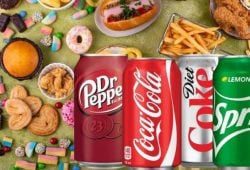 The rise of GLP-1 drugs for weight loss represents a remarkable shift in the way people pursue their health and wellness goals. It also appears to have begun reshaping consumer habits.
The rise of GLP-1 drugs for weight loss represents a remarkable shift in the way people pursue their health and wellness goals. It also appears to have begun reshaping consumer habits.
On the eve of the National Association of Chain Drug Stores (NACDS) Annual Meeting, Acosta Group released the findings of its latest proprietary study focused on GLP-1— a class of medicines that has gained tremendous attention in recent years for its effectiveness in slimming down. The research, entitled “GLP-1 & The Weight Loss Revolution Shopper Insights Study”, sheds light on the behaviors and perceptions of consumers who use these weight-loss drugs as well as on the opportunities that are emerging for brands and retailers across the health-and-wellness industry.
The report is based on a survey of 4,489 U.S. adults conducted from 10–19 February 2025. Among them, 332 were actively taking a GLP-1 at the time and 151 had stopped. From shopping patterns to treatment duration, the information collected offers a detailed perspective on the growing relevance of these medications in the daily lives of thousands of people.
READ ALSO: Meta expands Threads ads: What you need to know about this global update
What is GLP-1 and what is it used for?
The acronym GLP-1 has become an increasingly popular term in the health arena, especially in the context of weight loss. GLP-1 stands for glucagon-like peptide-1, a naturally occurring hormone whose main role is to regulate blood-sugar levels and appetite.
These medications were originally developed to manage type 2 diabetes, as they help stabilize glucose and boost insulin secretion. However, doctors noticed that patients on treatment reduced their caloric intake and, indirectly, lost weight—prompting further exploration of GLP-1 specifically as a slimming tool.
Today, many people looking to shed pounds turn to these drugs, either under medical prescription or following the advice of various health professionals. The Acosta Group study confirms the growing interest in GLP-1 products and shows how this therapeutic option has gained traction among those seeking effective results.
How does GLP-1 work?
The way GLP-1 promotes weight loss is tied to its impact on satiety and carbohydrate metabolism. By acting for an extended period on hormone receptors, GLP-1-based medicines slow gastric emptying and create a feeling of fullness, which reduces appetite. They also help control blood glucose, preventing sugar spikes that could trigger fat storage.
This dual mechanism (appetite control and improved glucose processing) translates into fewer calories consumed. The positive impact on the scale is often swift: many users report significant weight reductions—especially when treatment is paired with healthier eating habits and physical activity.
READ ALSO: Facebook Marketing and Advertising: The Facts Every Marketer Should Know
Short-term use: A growing trend
One of the most revealing data points in the Acosta Group study is that most consumers who take GLP-1 for weight management do not plan to stay on therapy long-term. According to the results:
- 69 % have been using the drug for less than two years.
- 53 % expect to stop before completing two additional years.
Moreover, among those who have already discontinued treatment, 90 % did so after less than one year. This aligns with broader concerns about the length of drug regimens and the dependency they can create.
In the words of Kathy Risch, SVP of Shopper Insights and Thought Leadership at Acosta Group: “Consumers’ overall high satisfaction with these weight-loss medications has been tempered primarily by concerns about side effects, weight gain if discontinued, and cost. It was particularly interesting to learn what lasting impacts a GLP-1 medication may have on consumers; they continue trying to maintain healthy eating habits even as the ‘food noise’ returns.”
In short, while users are pleased with their results, doubts persist about adverse effects, the possibility of regaining weight after stopping the drug, and the cost involved.
Satisfaction vs. dropout: Two sides of the same coin
The report notes that 84 % of participants are satisfied with the weight-loss results they achieved. Yet this positive figure contrasts with the high dropout rate. Specifically:
- 77 % of former GLP-1 users said they were satisfied with the weight they had lost.
- However, 76 % of respondents cited side effects as the main reason for interrupting or questioning continuity (36 % rated them mild, 17 % severe; the latter rises to 33 % among the Gen Z cohort).
- Cost was another key barrier, mentioned by 31 % of participants.
The emerging picture is one where therapeutic benefits are overshadowed by financial constraints and possible discomfort.
Consumers vs. side effects
Despite side effects—nausea and stomach upset topping the list—the study highlights that 85 % of affected users purchase products to manage them and/or to fill nutritional gaps. These purchases occur both in-store and online, and vary by generation:
- 55 % of Gen Z and 39 % of Millennials buy energy drinks or powders.
- 69 % of Millennials and 59 % of Gen Z choose vitamins and/or nutritional supplements.
Such buying behavior shows that, for many, GLP-1 therapy is not a standalone fix but part of a broader self-care plan—underscoring the potential for brands seeking to position themselves as allies in reducing unwanted effects and reinforcing healthy eating habits.
Consumer preferences for products
According to Acosta Group’s research, almost 80 % of consumers currently on GLP-1 conduct searches for products and health advice that support their weight-loss journey. Their sources include:
- Social media (40 % overall, 61 % in Gen Z).
- Medical professionals (37 %).
- Nutritionists (36 %).
In addition, 88 % of those using retailer apps and websites apply filters to find products that meet specific criteria—such as low-calorie options, no added sugar, or high protein.
Dietary changes: Beyond the medication
One of the most positive takeaways is that 95 % of consumers have improved their dietary habits while on GLP-1. Examples include:
- 55 % eat smaller portions (among Gen X this rises to 66 %).
- 53 % drink more water.
- 49 % choose healthier foods and fewer snacks.
Data also point to increased purchases of fresh fruit and vegetables (65 %), fresh chicken (42 %), unsweetened beverages, protein bars, and yogurts. Interest centers on products with specific properties:
- 75 % prefer items fortified with vitamins and nutrients.
- 74 % look for high-protein or protein-fortified products.
- 73 % value foods that promote gut health.
Even those no longer on the drug maintain certain healthy habits: 76 % continue eating the same amount or less food, while 24 % admit to a higher intake of snacks, meats and other calorie-dense items.
Implications for brands and retailers
High satisfaction with GLP-1 medications suggests that, as side effects and costs decrease, dropout rates could fall. Nonetheless, the study shows a segment willing to resume or continue treatment under certain conditions:
- 46 % of former GLP-1 users would consider taking it again to lose more weight.
- 47 % of Gen Z and Gen X would restart therapy if costs were lower or insurance covered it.
Jami McDermid, president of CROSSMARK Sales Agency, states: “As a result of the study, we have identified key implications for brands and retailers regarding product prioritizations and how we can best convey product benefits to support weight-loss journeys, both during and post GLP-1 therapy.”
Her comments reinforce the idea that brands and retailers must respond to a demand that goes beyond the drug itself. Key opportunities highlighted include:
- Strategically placing nutritional-support products near the pharmacy in grocery and drug-store chains.
- Clear labeling that showcases weight-loss benefits, since 91 % of Millennials, 90 % of Gen Z and 64 % of Gen X want to see this on the package.
- Strengthening digital presence with educational content, personalized recommendations and an enhanced e-commerce experience.
- Optimizing apps and websites to guide shoppers on GLP-1 therapy, making it easier to locate products aligned with their health goals.
Which brands of drugs use GLP-1?
Injectable medications:
- Albiglutide (Tanzeum®)
- Dulaglutide (Trulicity®)
- Exenatide (Byetta®, Bydureon®)
- Liraglutide (Victoza®, Saxenda®)
- Lixisenatide (Adlyxin®)
- Semaglutide (Ozempic®, Wegovy®)
- Tirzepatide (Mounjaro®, Zepbound™)
Oral medication:
- Oral semaglutide (Rybelsus®)

How was the study conducted? Methodology
The analysis is based on the “GLP-1 & The Weight Loss Revolution Shopper Insights Study”, carried out from 10–19 February 2025. It involved 4,489 adults in the United States, 332 of whom were taking a GLP-1 and 151 who had stopped. Respondents belong to Acosta Group’s proprietary community of more than 40,000 shoppers with diverse demographic profiles across the nation.
Acosta Group is a collective of retail, marketing and food-service agencies. With over 97 years of experience, the group connects its partners with people at every point of the consumer journey.
👉 Follow us on Google News.









